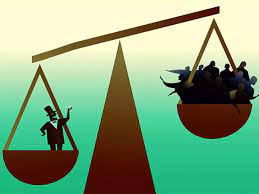
India’s three decades of economic growth have failed to democratize distribution with vulnerabilities based on caste and religion as the two undeniably still factor in conducting studies, framing policies.
Quamar Ashraf
NEW DELHI—The latest Word Inequality Report (WIR)-2022 has put India among the most unequal nations of the world. The report has been prepared by the Paris-based World Inequality Lab, a global research organization.
The report showing India in a “bad light” in managing economic disparity in the country has, however, not surprised the public at large nor the political masters. It is understandable.
Frankly, the report doesn’t identify inequal lots by their caste or religious identity. Resultantly, the government chose to keep a mum.
Above all, the current dispensation has been in the habit of staying in ‘denial mode’ – remember its apathetic response on the Human Development Index (HDI) report, which ranked India lower than its neighbours, including Pakistan and Nepal. Union ministers and the BJP leaders, along with a dominant media section, belittled it as everything in New India didn’t ‘appear rosy’. But sweeping the dirt under the carpet does not make the room clean.
The WIR, released recently, shows the top 1% of the population holds 22% of national income, exposing lacunas in the policies adopted in the post-economic liberalization world. According to an analysis of the report, under the British Raj (1858-1947) 10 percent richest took away 52 percent wealth which has now worsened further with 10 percent wealthiest taking away 57 percent of the country’s wealth. Precisely, post-independent India fared poorly in terms of wealth distribution. Income inequality in India today is worse than it was under British rule. It is not that the country has not progressed.
On the contrary, the report says that the country has made progress with its per capita gross domestic product increasing five times between 2000 and 2019. Still, the income is increasingly concentrated only in a few hands. The report, authored by economist and co-director of the World Inequality Lab, Lucas Chancel, along with economists Thomas Piketty, Emmanuel Saez, and Gabriel Zucman, says that the average national income of the bottom 50% stood at ₹53,610, the top 10% earned more than 20 times more, ₹11,66,520.
While the Left-leaning economists in the country might have got the opportunity to expose the West’s insidious capitalism, the situation in the Indian context, however, calls for analyzing the issue precisely from two perspectives: caste and religion. The two undeniably the entire socio-political setup of the country.
Various other studies in this regard have explicitly pointed out the system’s discriminatory approach in treating the so-called backward castes and Muslims. So that, poverty in Muslim minority – not minorities – and so-called backward castes, mainly Dalits, has been rampant.
United Nations Development Programme (UNDP) and the Oxford Poverty and Human Development Initiative (OPHI)’s global multidimensional poverty index (MPI), 2018, found that the Scheduled Castes/Scheduled Tribes and Muslims are the poorest of the poor in the country. It says every second person belonging to the Scheduled Tribe and every third person belonging to the Scheduled Caste remains poor. It further said every third Muslim is multi-dimensionally poor. Furthermore, the National Sample Survey Office (NSSO)- 2018 labour force survey “reports that the economic condition of Muslims does not show any signs of improvement.”
The Narendra Modi government should not be solely blamed for the declining socio-economic condition of Muslims. A year before Modi came to power at the Centre, the same NSSO had found that Muslims’ average per capita spending a day is Rs. 32.66, while it is Rs. 37.50 for Hindus, Rs. 51. 43 for Christians and Rs. 55.30 for Sikhs. In short, the difference between rich and poor is chiefly, if not solely, on the grounds of caste and religion, but media discourse on it is pretty different. The Muslim question is lost under the garb of ‘minorities’; the backward castes are being skirted under the Hindutva narrative to continue upper-caste hegemony.
The writer, a media analyst, can be contacted at [email protected]




